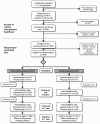The effectiveness of physical activity monitoring and distance counseling in an occupational setting - results from a randomized controlled trial (CoAct)
- PMID: 22578104
- PMCID: PMC3507818
- DOI: 10.1186/1471-2458-12-344
The effectiveness of physical activity monitoring and distance counseling in an occupational setting - results from a randomized controlled trial (CoAct)
Abstract
Background: Lack of physical activity (PA) is a known risk factor for many health conditions. The workplace is a setting often used to promote activity and health. We investigated the effectiveness of an intervention on PA and productivity-related outcomes in an occupational setting.
Methods: We conducted a randomized controlled trial of 12 months duration with two 1:1 allocated parallel groups of insurance company employees. Eligibility criteria included permanent employment and absence of any condition that risked the participant's health during PA. Subjects in the intervention group monitored their daily PA with an accelerometer, set goals, had access to an online service to help them track their activity levels, and received counseling via telephone or web messages for 12 months. The control group received the results of a fitness test and an information leaflet on PA at the beginning of the study. The intervention's aim was to increase PA, improve work productivity, and decrease sickness absence. Primary outcomes were PA (measured as MET minutes per week), work productivity (quantity and quality of work; QQ index), and sickness absence (SA) days at 12 months. Participants were assigned to groups using block randomization with a computer-generated scheme. The study was not blinded.
Results: There were 544 randomized participants, of which 521 were included in the analysis (64% female, mean age 43 years). At 12 months, there was no significant difference in physical activity levels between the intervention group (n = 264) and the control group (n = 257). The adjusted mean difference was -206 MET min/week [95% Bayesian credible interval -540 to 128; negative values favor control group]. There was also no significant difference in the QQ index (-0.5 [-4.4 to 3.3]) or SA days (0.0 [-1.2 to 0.9]). Of secondary outcomes, body weight (0.5 kg [0.0 to 1.0]) and percentage of body fat (0.6% [0.2% to 1.1%]) were slightly higher in the intervention group. An exploratory subgroup analysis revealed no subgroups in which the intervention affected physical activity. No adverse events were reported.
Conclusions: The intervention was not found effective, and this study does not provide support for the effectiveness of the workplace PA intervention used here.
Trial registration: ClinicalTrials.gov identifier: NCT00994565.
Figures


References
-
- Haskell WL, Lee I-M, Pate RR, Powell KE, Blair SN, Franklin BA, Macera CA, Heath GW, Thompson PD, Bauman A. Physical activity and public health: updated recommendation for adults from the American College of Sports Medicine and the American Heart Association. Circulation. 2007;116:1081–1093. - PubMed
-
- World Health Organization. The world health report 2002: reducing risks, promoting healthy life. 2002. Geneva: World Health Organization; 2002. - PubMed
-
- Aldana SG, Pronk NP. Health promotion programs, modifiable health risks, and employee absenteeism. J Occup Environ Med. 2001;43(1):36–46. - PubMed
Publication types
MeSH terms
Associated data
LinkOut - more resources
Full Text Sources
Medical
Miscellaneous

